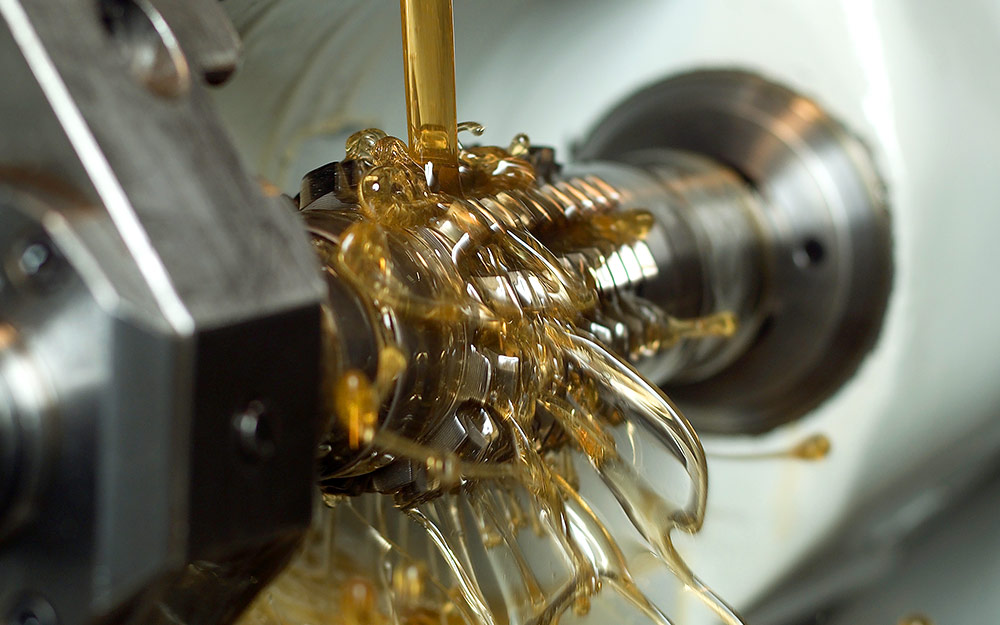The question of whether or not to supply airline lubrication often comes up during the installation of pneumatic components, in the design of new machinery, or when rebuilding or retrofitting existing equipment. Understanding the pros and cons of using airborne lubrication can save you time, money, and trouble. To get started, first check the component’s lubrication requirement by reading the manufacturer’s product precautions. Neglecting this simple step may void the product warranty, so doing this easy homework up front pays off.
When lubrication is required, the desired effect is to provide just enough airborne oil to create a thin film of lubricant between the mating surfaces of moving parts to extend the life of the pneumatic component. Careful attention must be given to specifying, installing, and correctly adjusting lubrication equipment and using the correct lubricant to accomplish this task successfully. Again the manufacturer’s product literature will likely be the best source of information to correctly match the product’s capabilities to the application requirements.
We must also be aware that some applications have environmental extremes that require special attention to component lubrication. In high heat environments, machinery is subjected to being washed down for cleaning, or where chemical contamination may occur, the lubricant may be compromised or rinsed away
and need to be replaced on a regular basis to extend the life of a pneumatic component, primarily linear actuators. In these situations, the life of the pneumatic component may be extended for a period of time by providing airborne lubrication, and there is a reasonable argument for supplying it. By the same token, it is important to note these underlying factors actually exist and that oil is not being used simply because “that’s the way we’ve always done it.”
So now that you have read the manufacturer’s product precautions and checked for conditions that might require lubrication, what if nothing indicates that lubrication should be used? Should you install a lubricator anyway, perhaps just to “play it safe”?
Consider the consequences first.
For example, standard lubricators are adjusted with a general procedure based on counting the number of drops per minute through a sight dome and correcting with a needle valve typically as the machine is running. How many drops per minute is often a matter of estimate rather than careful experimentation based on peak air flow demand, distance the lubrication has to travel, and the nature of the equipment’s lubrication requirements. Given this, excessive lubrication is often applied. The lubricant ends up underneath machinery and in the surrounding air. In extreme cases of over-lubrication, oil mist may be visible as a haze throughout the surrounding environment. If the lubricator is over-adjusted to correct the issue, machine damage from lack of lubrication may occur, and often over-lubrication is tolerated for this reason.
Oil in the environment should be considered the same as an uncontrolled hazardous substance. It constitutes an increased risk of fire, health-related issues such as respiratory illness, and falling incidents. If lubricators are being correctly applied and excess oil is not apparent in the atmosphere, there is always the microscopic oil you cannot see still floating around in the air.
When the incorrect oil is used or if someone does not fill the lubricators on a timely basis, equipment damage is often the result. Hopefully the machine being down won't be at the worst possible moment. In the meantime you are still paying for purchasing lubrication equipment, lubricant, oil dry for spills, and the fellow with the best intentions who made an honest mistake.
When lubrication is applied where application concerns do not require it and lubricators are incorrectly adjusted, the results can be as costly as summarized in Table 1. If your evaluation process has included a review of the manufacturer’s recommendations and no environmental conditions exist that may wash away or degrade lubrication over time, then what other options are available?

Fortunately, there is a straightforward answer to this question. The majority of contemporary pneumatic components does not require additional lubrication and have the added benefit of using less energy than their predecessors.
Today’s pneumatic linear actuators now incorporate specialty piston seals that cup and store long lasting types of grease that remain for tens of millions of cycles. Gone, for the most part, are the simple o-ring piston seals of yester-year that needed a continual oil supply to keep from rolling or extruding out of position. Actuator rod bearing materials exude lubricity while rod seals evenly spread, yet retain, a maximum amount of grease. Directional control valve design has evolved to extend the life of the component to tens of millions of cycles or more with clean dry air, while at the same time reducing energy consumption to fractions of a Watt.
When designing new equipment, the choice is clear that “non-lube” components are of considerable advantage, but what if your existing machinery is already using lubricators? What if you want to address the environmental health, and cost issues that now come to mind, but do not have unlimited resource to retrofit every machine?
Immediate action to help clear the air can be taken by using a device known as an exhaust cleaner. This type of product can collect the exhaust air from single or multiple directional control valves and reclassify air by removing the bulk of oil mist at microscopic levels. Exhaust cleaners serve a useful purpose in application where lubrication cannot be avoided and as an intermediate step in weaning your operation off the harmful and costly effects of unnecessary lubrication.
The answer to the question of “To lube or not to lube?” starts with reviewing current conditions and practices and changing how you think about how and why you specify lubrication. In your efforts to change the game by making your environment healthier and less costly to maintain, you can pass along the benefits of eliminating unnecessary lubrication by making informed decisions in your machine design and maintenance practices.
Written by Richard F. Bullers,
CFPPS as published in Fluid Power Journal, Tech Directory 2010

